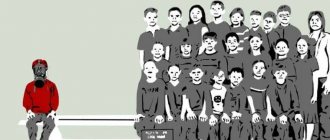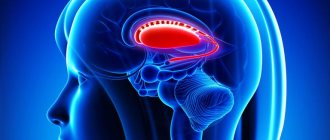Paranoia is a severe psychiatric illness characterized by the development of logically constructed delusional ideas. This is one of the first diseases that began to be treated in modern psychiatry, along with the treatment of schizophrenia and neuroses. With paranoia, the patient does not experience negative symptoms, the integrity of the personality is preserved to some extent and there are no disturbances in perception - hallucinations.
The term "paranoia" was coined by the German psychiatrist Karl Ludwig Kahlbaum in 1863. Later, another psychiatrist, Emil Kraepelin, described paranoia as an independent disease. For a long time, paranoia was considered in classical psychiatry as an independent mental disorder, and in Soviet and Russian psychiatry it was customary to distinguish paranoid syndrome with paranoid delusions.
Treatment
In medicine, an integrated approach consisting of psychotherapeutic techniques and medications is used to treat paranoia.
Depending on the cause, severity of symptoms and other factors, the following may be used:
- antidepressants;
- tranquilizers;
- antipsychotics;
- medications that have a sedative (calming) effect.
Meetings with a psychotherapist will help control symptoms and correct the patient’s thoughts and behavior. Equally important are group sessions with the patient’s loved ones, which will teach them how to properly respond to manifestations of the disorder.
Paranoia often manifests itself as a consequence of a person’s alcohol or drug addiction. In this case, consultation with a narcologist is necessary.
Causes of paranoia
As with other mental illnesses, the causes of paranoia are a genetic predisposition and some external trigger that triggered the development of the disease. At the moment, science does not know which genes are responsible for the development of paranoia and what specific triggers include this disorder. Paranoia can co-occur with other illnesses such as generalized anxiety disorder and depression. Sometimes depression is a consequence of paranoia, since it becomes difficult for a person to live with the existing picture of the world, according to which he is constantly being persecuted and wants to harm him.
A patient suffering from paranoia accepts for himself a certain axiom that cannot be proven.
In many cases, individual signs of paranoia can develop in old age during degenerative processes in the brain, for example, with atherosclerotic lesions of cerebral vessels, Alzheimer's disease, Parkinson's disease, Huntington's disease and others. Also, the development of paranoia can be caused by taking psychoactive substances - hallucinogens, amphetamines, alcohol and some medications.
Prevention
As preventive measures to prevent the development of paranoia, experts advise:
- prevent stressful situations;
- to refuse from bad habits;
- organize your daily routine;
- spend more time in the fresh air.
The main difficulty of treatment is the negative attitude of the patient himself. Therefore, if you notice symptoms in your loved one, you should not hope that he will consult a doctor on his own. It is necessary to come to the appointment with him as early as possible, since the effectiveness of the treatment depends on this. You can make an appointment with a psychotherapist at a medical clinic by phone.
Symptoms of paranoia
The main signs of paranoia are delusional ideas and, as a result, negative emotions towards others (resentment, hostility, pathological jealousy), as well as delusions of grandeur and the inability to perceive criticism and adequately evaluate oneself. Delusion of persecution, which all patients with paranoia suffer from, is an inadequate perception of reality, a certain fixed idea that constantly accompanies a person in his everyday life and is not questioned. With paranoia, a person is convinced that someone is following him and wants to harm him. This disease differs from other diseases, such as paranoid schizophrenia, in that a person suffering from this disorder does not withdraw into himself or lose himself as an individual. People suffering from paranoia are characterized by unhealthy suspicion, a tendency to see the machinations of enemies in random events, and to build complex conspiracy theories against themselves. However, in other respects they maintain logical thinking.
Paranoia can co-occur with other illnesses such as anxiety and depression.
If such a person is sufficiently socialized, that is, other people continue to communicate with him, he can work at the same job for many years, he may have acquaintances and friends. As a rule, those who suffer from paranoia do not have close friends. However, a patient with paranoia may well have a family who will stay with him until the paranoid delusion intensifies and the patient becomes dangerous to himself or others.
Paranoia schizophrenia
E. Bleuler in 1911 suggested the unity of paranoia and schizophrenia. Speaking of paranoia, E. Bleuler implies an incurable condition with an unshakable, well-founded delusional system built on a painful basis. In his opinion, paranoia is not characterized by significant disturbances in thinking and affective life. The disease proceeds without subsequent dementia and hallucinations. The stupidity characteristic of paranoia must be distinguished from dementia. It is somewhat reminiscent of the state of people who are engaged in one-sided work and therefore think and also observe in one direction. Many researchers attach great importance in the development of paranoid disorder to the structure of affect, as well as the preponderance of affect over logic.
The differences boil down to the fact that cases of paranoia throughout the entire duration of the disease retain delusions as the only symptom, and in schizophrenia, delusions precede other symptoms (autism, hallucinations, personality disintegration). The disease is characterized by a later age of patients and a predominance of cyclothymic and syntonic subjects among paranoids.
Paranoia example: a patient in the past who wrote a poem that was published in a newspaper begins to consider himself an extraordinary writer. He considers himself an outstanding poet and believes that he was underestimated, ignored, envied and therefore no longer published. Your whole life comes down to proving your poetic talent. It is typical for a paranoid person to talk not about creativity, but about his place in poetry. As proof, he carries this poem with him, reciting it endlessly.
Clinical picture
The clinical picture is determined by the development of paranoid syndrome (see). The formation of delusions, characteristic of P., most often takes the form of delusions of grandeur and persecution (see Delusion). Paranoids with ideas of greatness include patients with delusions of high origin, as well as “inventors”, for example, with ideas for creating a perpetual motion machine, aircraft of an unprecedented configuration. Paranoid people with delusions of invention are dominated by daydreaming, altruism - the so-called. paranoia of desire; later, elements of pressure may appear, a struggle for recognition of one’s discoveries - paranoia of struggle. There are paranoids with a predominance of delusions of damage, delusions of love, delusions of jealousy, sensitive delusions of relationship, hypochondriacal delusions; with delusional ideas of messianism - the so-called. prophets, saints, mystics, as well as querulants, who litigate, sue, interpret laws one-sidedly, recognizing as significant only what testifies in their favor (thus, a quarrel associated with minor everyday troubles can gradually acquire the character of a permanent conflict , in which neighbors, co-workers, and public organizations are consistently involved).
The content of the ideas of persecution can be various harassment related to the professional or social activities of the patient (plagiarism, defamatory rumors, attempts to provoke and compromise in order to deprive of a place), as well as the possibility of physical destruction (poisoning, organizing an assassination attempt, reprisal being prepared by the secret services, etc.) .
Paranoid people often commit socially dangerous actions. Distinguished by their persistence in defending their ideas (especially in cases of delirium of invention, reform, as well as litigiousness), they often come into conflict with persons who, as it seems to them, are preventing the implementation of their plans.
Patients with delusions of love pursue with their harassment persons who, in their opinion, show them signs of attention.
The most dangerous are the so-called. persecuted pursuers, that is, patients who have taken the path of fighting imaginary enemies. Some of them think over plans for revenge, carefully weigh, and sometimes carry out aggressive acts. There are no obvious memory or attention disorders observed. There are no true illusions of perception.
P. develops slowly over a number of years. Premorbid paranoids are characterized by an increased sense of self-esteem, despotism, thoroughness, ambition, and a tendency to abstract constructions based on superficial analogies. The decisive impetus for the manifestation of delirium (usually over 25-30 years) can be a minor random event; in some cases, delusional “insight” is associated with false memories. There is no consciousness of illness. As E. Kraepelin said, “the fundamental immutability of delusional ideas” is the main sign of P. The mood of patients corresponds to the content of their delusional ideas; During the period of manifestation or exacerbation of delirium, tension and anxiety may be noted. The development of delirium also occurs slowly, while it does not undergo significant changes and remains limited and uniform. Usually it is possible to identify a period of illness, after which the formation of new delusional ideas is suspended, and then the delirium expands only due to minor details. P.'s outcome is residual delusion, which gradually loses its affective coloring, as a result of which delusional ideas have less and less influence on the patient's actions. True dementia does not develop.
Forecast
As a rule, paranoia is a pathological lifelong condition in psychology.
Therefore, the prognosis is unfavorable. With paranoid personality disorder, the condition can be stabilized for a long time, but with age, the pathology will progress, and delusional ideas will become more pronounced. The patient's condition with secondary paranoia, which has developed as a result of brain damage, depends on the course of the underlying pathology.
Chronic alcoholics experience persistent paranoia. With short-term paranoia that has developed as a result of the use of psychotropic drugs, the prognosis is most favorable. Once you stop taking the medication, the symptoms go away quickly.
Pondyakova Elena · Jan 26, 2021
Types of paranoia
There are several types of disease.
Alcoholic paranoia is a chronic delusional psychosis that develops in patients with alcoholism. The patient is characterized by systematic delusions of jealousy, and occasionally ideas of persecution.
Struggle paranoia refers to an outdated term and corresponds to the idea of paranoid development, which proceeds with increased fanaticism and activity, and is also focused on the defense of supposedly violated rights.
Paranoia of desire is an outdated term that is used to denote delusions of mercy, as well as love and erotic overtones.
Involutional paranoia is a psychosis characterized by systematized delusions. This condition occurs in women before menopause, a period of 40-50 years. The disease is characterized by an acute onset, as well as a long course of mental disorders.
Hypochondriacal paranoia is a systematized hypochondriacal delusion that begins with the stage of senesthopathy, which is characterized by delusional interpretations.
Acute paranoia is an acute psychosis that occurs with hallucinatory-delusional and stuporous symptoms.
Acute expansive paranoia is a variant of acute paranoia, which is characterized by megalomanic delusional ideas (of greatness, invention, power or religious content).
Persecutive paranoia means persecution. The ill person suffers from delusions of persecution.
Sensitive paranoia includes sensitive delusions of relationships. This condition is observed after organic brain damage, after brain injury or nutritional dystrophy. Humans are characterized by vulnerability and sensitivity with organic damage. The patient is conflicted.
Paranoia of conscience is a delusion of self-blame or one's own guilt. Manifestations are characteristic of a condition such as depression.
Suggestive-delusional paranoia is marked by a predominance of hypnotic charm.
Litigative paranoia is a type of struggle characterized by litigious behavior.
Chronic paranoia is characterized by paranoid delusions. The disease occurs at involutional age (45-60 years). Despite its chronic course, it does not lead to the development of dementia.
Russian paranoia
Photo: YURY MARTYANOV
Le Figaro
Paris, France
It doesn’t matter that the oppositionists are a super-minority in Russian society, they nevertheless clearly frighten the Kremlin. The brutal suppression of two demonstrations in Moscow and St. Petersburg demonstrates the nervousness in the corridors of Russian power. But the ragtag coalition led by former world chess champion Garry Kasparov poses no threat to a regime made increasingly authoritarian by Vladimir Putin's bid to restore Russia to its former glory.
All television channels and most other media are under the control of the Kremlin, so it is not entirely clear how the speeches of several thousand people, practically passed over in silence in Russia, can pose a threat to public order. Beatings with batons and detentions only lead to increased tension in society and spoil the image of Russia, which is gradually losing the credit of sympathy it had in Europe. But a negative impression abroad is not something that can make the Kremlin become more accommodating...
Repressions against Kasparov's friends will not increase their popularity in the eyes of the majority of their compatriots.
Forceful intervention will not cause a wave of criticism against the authorities. By reacting with such force to any hint of dissent, the Kremlin betrays its surprising weakness. Eight months before the parliamentary elections and a year before the presidential elections, which will see the transfer of power to Putin's successor, the Kremlin wants to keep absolutely everything under control and does not leave the slightest freedom of maneuver for the opposition. This paranoia, regardless of whether it comes from the owner of the Kremlin or from his entourage, risks creating danger where there was none.” The Daily Telegraph
London, UK
"Putin's kingdom of fear
During public demonstrations in Moscow and St. Petersburg, protesters were in the overwhelming minority compared to heavy-handed law enforcement. This is the style of President Vladimir Putin. The British habit of reinforcing liberal traditions while ignoring small peaceful demonstrations earns him nothing but contempt.
Putin's ruthlessness raises a number of difficult questions for the West.
If, for example, Boris Berezovsky were to die tomorrow in a mysterious car accident, there would be little we could do except admit that we were powerless to stop determined foreign killers from operating on our streets. Of course, we have no evidence that Putin orders the killing of his opponents, but he is in no hurry to condemn such acts or publicly moan about such accusations, since he is quite comfortable with the image of a person capable of such cruelty. In other words, the only emotion he wants to evoke in people both at home and abroad is fear. Any other reaction leaves him indifferent. We are not used to dealing with such insensitivity, but we should find a strategy for dealing with this type as soon as possible.” Die Tageszeitung
Berlin, Germany
"A pure autocrat
It's no news that in Vladimir Putin's controlled democracy, open opposition to the regime is harshly suppressed.
Methods of suppression are also well known. And yet, the events that unfolded over the weekend during the anti-Putin demonstration in Moscow had a new quality, even by Russian standards. The forces of law and order seemed to have broken free: they attacked not only the participants of the demonstration, but also random passers-by. Dozens of detainees were forced into police vans like cattle. What was happening clearly showed: people and their rights in Russia are literally being trampled underfoot.” The New York Times
New York, USA
“Russia’s strategy: save polar bears by allowing legal hunting of them
Russia has chosen a counterintuitive method to save endangered animals: it is proposing to legalize their hunting.
For the first time since the Soviet Union banned the practice more than 50 years ago, the government is preparing to allow hunters to kill polar bears. Animals are increasingly coming to the coastal Chukchi villages, which is explained by a decrease in sea ice due to global warming on the planet.
While many experts warn that polar bears are under threat, scientists, environmentalists and local residents say they hope legal hunting can curb poaching. If hunters are allowed to shoot at least some bears legally, supporters of the project argue, they will be less tempted to break the law for the bear meat that is now secretly consumed as a delicacy here, and for the thousands of dollars that can be fetched for the skin.
Global warming poses a threat to more than just bears. It also threatens the existence of people who live here a life much closer to nature than in most other places on the planet. Since 2003, at least three fatal bear attacks on humans have been recorded in Chukotka. In the village of Vankarem, where there are 200 residents, most of whom are Chukchi, their own version of the people's patrol program was created. There is a patrol of hunters in the village who monitor the autumn appearance of bears near housing and try to keep them at a distance.
The resumption of legal hunting has the support of some of the world's leading polar bear experts; it is also supported, albeit less willingly, by organizations such as the World Wildlife Fund. 'We support effective management,' says Viktor Nikiforov, director of the fund's regional programs in Russia. 'If hunting becomes a small part of such management, we can go for it.'
The column is led by Ksenia Kiseleva
What is paranoia
Paranoia is not when you talk to a cat, but when you are afraid to say too much in front of him, says a popular joke on the Internet. She aphoristically conveys an important feature of this mental disorder. They talk about paranoia when a person for a long time has the feeling that there is some kind of conspiracy around him or that he is being persecuted in one way or another.
Paranoids often have a distorted view of reality: it seems to them even more hostile than it actually is. In the random actions of others, they can detect consistency and logic directed against them. They can associate routine events with malicious intent. They may blame you for missing their socks or see the machinations of the world government in bad weather over the weekend.
It is known that paranoia is often accompanied by a feeling of powerlessness and depression. Given their suspiciousness and problematic character traits, paranoids often remain lonely and isolated.
Diagnosis of paranoia
To diagnose this disease, the patient must undergo a clinical interview with a psychiatrist. During the appointment, the specialist identifies how long ago the symptoms of the disease began, what served as the trigger for the onset of the development of the disorder and, most importantly, what or who specifically is associated with the delusion of persecution. After this, it is important to find out whether the person chosen as the object of delusion, those around him or the patient himself are in danger. At the end of the clinical interview, the specialist needs to decide whether the patient needs hospitalization or whether outpatient treatment can be prescribed in this situation.
Treatment of paranoia
Treatment of paranoia takes a long time - sometimes more than 10 years. The main goal of psychotherapy is to convince the patient that some of his thoughts and certain beliefs are painful. A psychotherapist teaches a person to notice paranoid thoughts in time and not to get involved in them so that they do not lead to action. This is very long and hard work. Patients who do not require hospitalization and continue to function in society, as a rule, do not stay for long-term treatment, and only attend psychotherapy for a month or two. Paranoia is a chronic disease that lasts for many years, and, unfortunately, there is no cure for it. It takes root, its symptoms begin to appear more acutely, and ultimately, when the patient ends up in the hospital or for psychotherapy, the disease is already in an advanced state.
- Diseases and disorders











